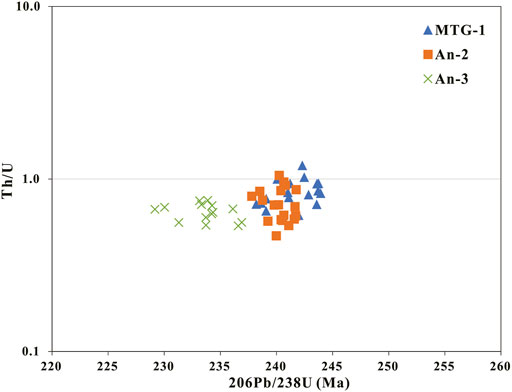Zircon U–Pb Dating of Tuff Layers in the Middle–Upper Triassic Strata of Successions and Sedimentation of Chang 7 Member in the Ordos Basin, China
- 1State Key Laboratory of Oil and Gas Reservoir Geology and Exploitation, Chengdu University of Technology, Chengdu, China
- 2School of Energy, Chengdu University of Technology, Chengdu, China
- 3Exploration and Development Research Institute, Changqing Oilfield Company of PetroChina, Xi’an, China
- 4School of Sedimentation, Chengdu University of Technology, Chengdu, China
During the Late Triassic, the southern margin of the Ordos Basin was influenced by the Indosinian Movement, in response to closure of the Paleo-Tethys Ocean. Thinly bedded tuff layers are exposed near the base of the Middle–Upper Triassic formations (Chang 8/7/6 members) in the Ordos Basin. Tuff samples from drilling core (well An-35) and outcrop (Motiangou section) samples in the Yanchang Formation were studied by the detailed field work. Igneous zircon crystals were picked and analyzed by the instruments of cathodoluminescence and laser ablation inductively coupled plasma mass spectrometery (LA-ICP-MS). The timing of volcanic activity was determined by means of high-precision zircon age. Combining tectonic setting and paleogeographic reconstruct, the ages of tuff layers indicate that volcanic activities occurred at three peaks (241.6 ± 1.1 Ma, 240.2 ± 1.1 Ma, and 233.5 ± 1.2 Ma) from the top of Chang 8 Member to the Chang 7 Member. The results implied that the volcanic activities lasted from Ladinian to Carnian, as well as define the sedimentary duration of the Chang 7 Member with a deposition rate of 1.34 cm/ka.
Introduction
The Late Triassic tuff layers recorded the volcanic activities in the Ordos Basin (Meng and Zhang, 2015; Yang et al., 2017). Intense orogeny during the Indosinian period led to massive volcanic activity in the Qinling orogenic belt (Zhang et al., 2014; Zhang et al., 2017). The Indosinian Movement led convergence between the Yangtze Plate and North China Plate in a scissor style (Zhao et al., 1992), and closure of the Paleo-Tethys Ocean (Mianlue suture) (Jiang et al., 1992). This orogenic event had a profound impact on the structure and sedimentary pattern of the Ordos Basin. The Indosinian Movement results in the transformation from marine to continental sedimentation in the Ordos Basin (Ma et al., 1993).
A set of tuff layers are widely found in the Upper Triassic formations of the Ordos Basin (Chang 8/Chang 7 members), which recorded the synchronous tectonic–magmatic events of the Qinling orogenic belt (Zhang et al., 2009; Qiu et al., 2014; Deng et al., 2018; Xu et al., 2019). Through the study of the tuff layers, it also helps to understand the process of sedimentation in the Ordos Basin, especially the sedimentary duration of Chang 7 Member. The eruption age and source of the tuff layers at the bottom of the Upper Triassic formations are of great significance for the study of the sedimentation of the basin and surrounding orogenesis. The stratigraphic age of Chang 7 Member is quite controversial, previous studies of paleontology considered it to Ladinian—Carnian in age (Wu et al., 2001; Li et al., 2008). Volcanic zircons from tuff layers from the Chang 7 Member have been tested by various U/Pb methods. The igneous U–Pb zircon crystallization ages are between 241.3 ± 2.4 and 234.3 ± 2.8 Ma in the lower section of Chang 7 Member, and 228.2 ± 2.08 Ma in the upper section (Liu et al., 2013; Yang and Deng, 2013; Zhang et al., 2014; Deng et al., 2018; Zhu and Cui, 2019). A young age (222.2 ± 2.1 Ma) at the top of Chang 7 Member was reported according to LA-ICP-MS analysis (Yang and Deng, 2013). Furthermore, biostratigraphic and ID-TIMS ages suggested that the lower section of Chang 7 Member was deposited since the Middle Triassic (Deng et al., 2008; Zhu and Cui, 2019). U–Pb ages of volcanic zircons in the upper section of Chang 7 Member are between 234 Ma and 236 Ma (Sun et al., 2020). A recent CA-ID-TIMS dating (240.95 ± 0.03 Ma) was obtained on tuff layers in the lower section of Chang 7 Member (Jin et al., 2021). Even with the abundant data of the study area, the ages of initial volcanic activities are still in debate. To have better age constraints on the initiation of volcanic activity, tuff layers within Chang 7 and 8 members were collected from the outcrop and drilling core. Furthermore, the volcanic activities in the Qinling orogenic belt and sedimentation of Chang 7 Member are verified and calibrated.
Geologic Setting
Tectonic Background in the Ordos Basin
Since the Middle Triassic, the whole Asian region experienced the closure of the Paleo-Tethys Ocean basin due to the initial Indosinian Movement. The South China block gradually converged with the North China Plate in the north and the Gondwana block group in the west, resulting in the Qinling–Dabie–Sulu orogenic belts (Deng et al., 2008; Wang et al., 2010; Chen et al., 2011).
The Ordos Basin is a craton basin with an area of approximately 38 × 104 km2 (Yang and Deng, 2013). The stratigraphic sequence thickness is about 4–5 km, which deposits from the Proterozoic to the Cenozoic (Zou et al., 2012). The Ordos Basin was in the low-latitude region (about 30°N) with a temperate to subtropical climate in the Middle–Late Triassic (Figure 1, Ji et al., 2010). After the collision between the Yangtze Plate and the North China Plate (Xie and Heller, 2013; Dong et al., 2015), the southern margin of the basin evolved into a depression and formed a deep lacustrine sedimentation.
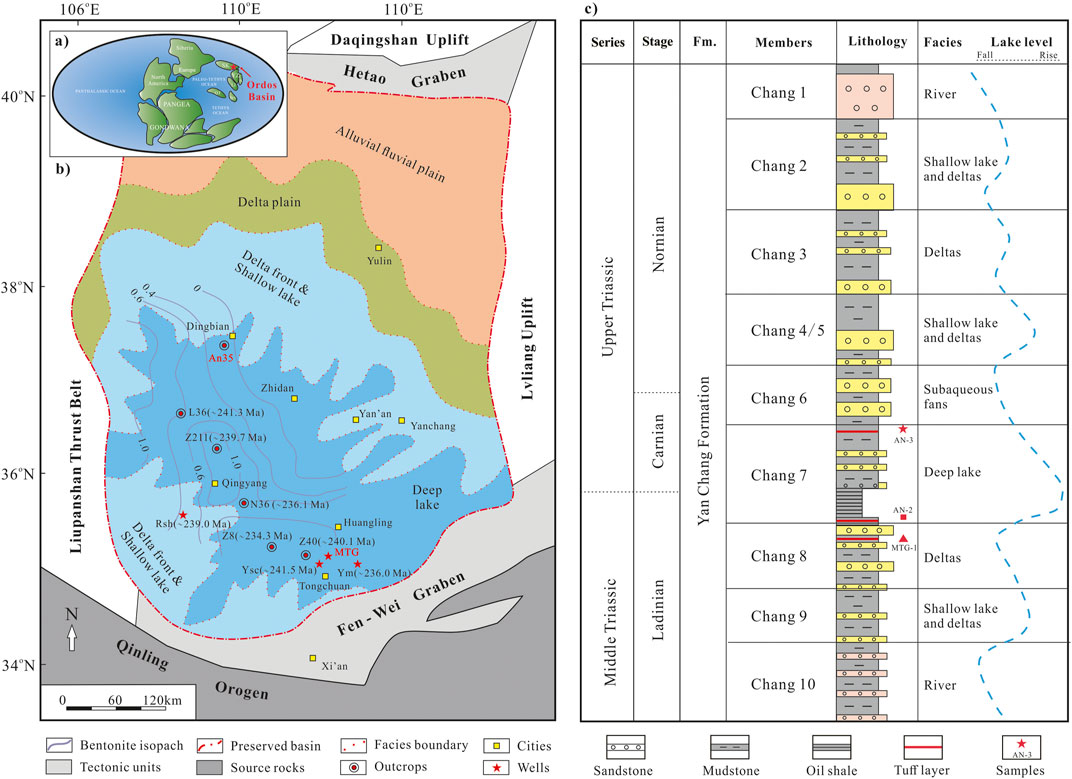
FIGURE 1. Geographical and geological location of the Ordos Basin during the Middle–Late Triassic. (A) Middle Triassic paleogeographic map indicates the study locations (The base map is modified from Scotese (2014); Zhang et al. (2019). (B) Preserved boundary of the Ordos Basin and sedimentary facies distribution of the Yanchang Formation (modified from Zou et al., 2012; Yang and Deng, 2013; Yang et al., 2017; Zhang et al., 2019; Sun et al., 2020). The map also shows the orogenic belts around the basin. The position of the studied well (An-35) and outcrop (MTG) are indicated by a red circle and star. (C) Lithology and division of the Yanchang Formation (Zhang et al., 2019).
Sedimentation of the Ordos Basin
The Yanchang Formation is a significant oil-bearing sequence, including delta, fluvial, and lacustrine facies, which deposits from the Middle Triassic to the Late Triassic. It consists of 10 members, with numbers of Chang 1 to Chang 10 upward, according to rock assemblages (Sun and Dong, 2019a; Sun and Dong, 2019b; Sun and Dong, 2020). A series of tuff layers were found in the Yanchang Formation (Figure 2, outcrop and drill core). The Chang 7–10 members were mainly deposited in the Middle Triassic, while the Chang 1–6 members were formed in the Late Triassic. The lacustrine deposition reached the largest area in the Chang 7 Member (Ji et al., 2010), which was caused by the rapid depression of the basement (Yang and Deng, 2013).
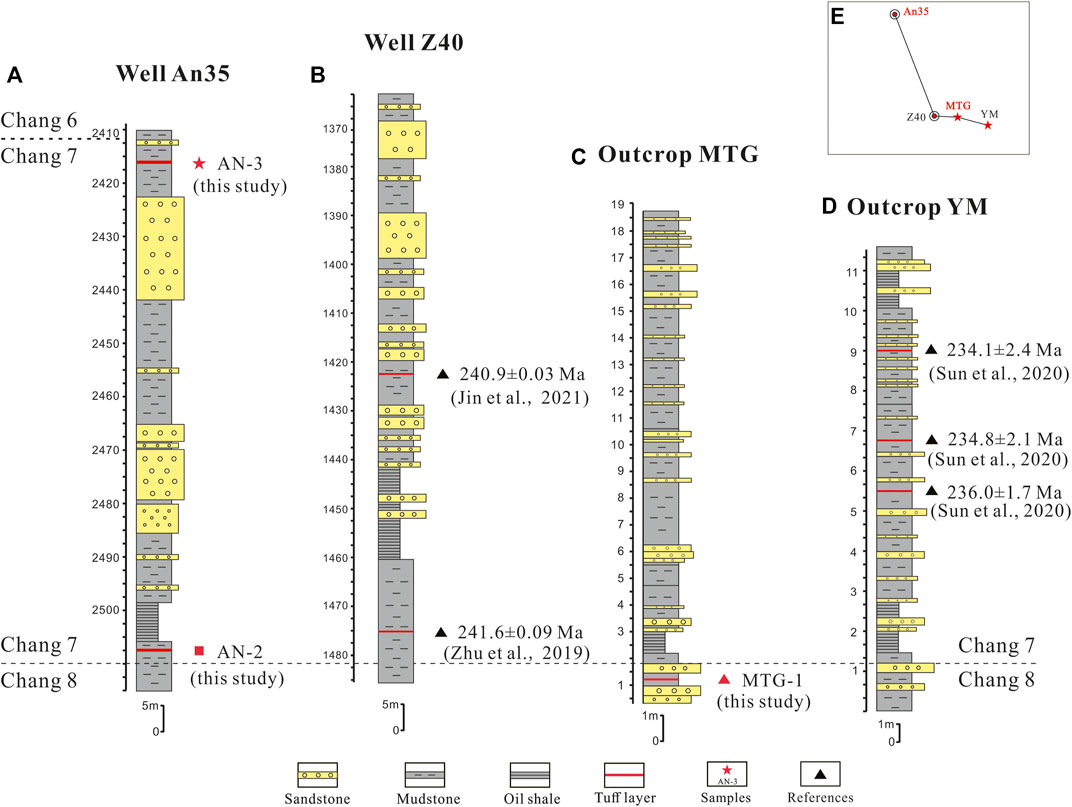
FIGURE 2. Lithology and division of the Chang 7 and Chang 8 members. (A) Lithology of the well An-35 (this study). (B) Lithology of the well Z40 (Jin et al., 2021). (C) Lithology of the outcrop MTG (this study). (D) Lithology of the outcrop YM (Sun et al., 2020). (E) Location of mentioned wells and outcrops.
The trend of decreasing thickness of tuff layers toward the north in the Yanchang Formation suggests that the volcanic activity originated in the south of the Ordos Basin since the Middle Triassic (Qiu et al., 2014). According to geochemical characteristics, the composition of tuff layers is mostly andesitic and rhyolitic (Qiu et al., 2014). It suggests that the tuffs were sourced from eruption of calc-alkaline volcanic arc in the Qinling orogenic belt (Qiu et al., 2014).
Materials and Methods
Sampling and Stratigraphy
We collected one sample (MTG-1) from the outcrop and two samples (An-2, An-3) from well An-35 (Table 1, Figure 2). From the perspective of biostratigraphy, previous researchers have carried out detailed profile studies on the Yanchang Formation (Zhang et al., 2019; Sun et al., 2020). Several sets of tuff layers are found at the boundary of the Middle–Upper Triassic, which interbeds in the dark oil shale (Zhang et al., 2019).
The studied core is collected from well An-35 in Dingbian County, Shanxi Province, North China. The thickness of drilling core strata is 99.87 m between the lower section of Chang 6 Member and upper section of Chang 8 (Figure 3B). The drilling core of this well contains a series of tuff layers which are suitable for geochronological analysis. The whole drilling core is composed of three units. In the descending order, unit 1 (boundary of Chang 7/6 members) is dominated by tuff layers, black, silty mudstone, and fine sandstone. Unit 2 (middle of Chang 7 Member) consists of dark, laminated mudstone and thick sandstone. Unit 3 (boundary of Chang 8/7 members) includes organic-rich oil shale, fine sandstone, and tuff layers. Notably, the thick tuff layers interbed among the Chang 7 Member (from top to bottom).
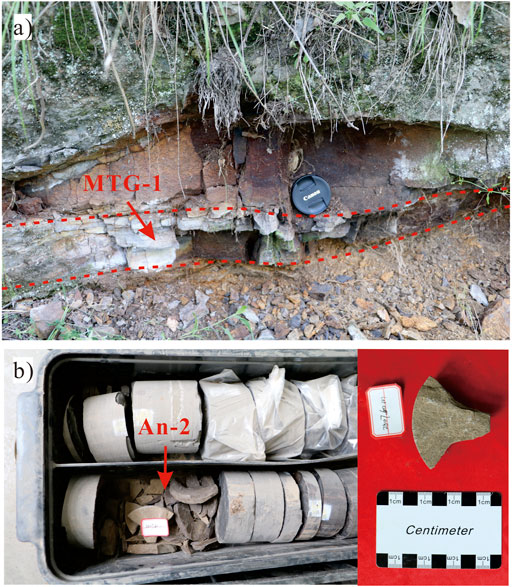
FIGURE 3. Pictures shows the Yanchang Formation. (A) Tuff layers of the outcrop MTG; (B) tuff layers of the well An 35.
The studied outcrop is located at the Motiangou (MTG) section in the Tongchuan area, Shanxi Province, North China. The whole profile is 41.52 m from the Chang 7 Member to Chang 8 Member (Figure 3A). The measured section preserves several tuff layer records, which were collected for zircon isotopic analyses. The whole profile is lithostratigraphically divided into two parts. The upper part is Chang 7 Member, which consisted of black oil shale and black mudstone and fine sandstone interbeds. The underlying Chang 8 Member is composed of gray, laminated mudstone, dark silty shale, and a set of thick fine sandstone. Notably, there are several tuff layers interbedded along the profile.
Zircon U–Pb Dating
Magmatic zircon was extracted from bulk samples with heavy liquid and magnetic separation in Chengxin Technology Co., Ltd. in Hebei Province, China. More than 300 grains were selected from three samples and embedded in epoxy resin and imaged by cathodoluminescence (CL) to locate the appropriate analysis points in the zircon oscillation zone. The LA-ICP-MS dating was performed by Wuhan Sample Solution Analysis Technology Co., Ltd., Wuhan, China with a GeolasPro laser ablation system (COMPexPro 102 ArF excimer laser). An Agilent 7700e ICP-MS instrument was used to acquire ion signal intensities. Helium is used as the carrier gas. In this study, the size of the laser spot was 30 μm. The external standard is zircon 91,500 for U–Pb dating and glass NIST610 for trace element calibration. The background acquisition was 15 s in each analysis, and 25–35 s for sample data acquisition. The ICPMSDataCal 10.7 was used for trace element analysis and U–Pb dating (Liu et al., 2010) with the ComPbCorr#3.18 program for lead correction (Andersen, 2002). The ISOPLOT 3.75 program was used for probability density distributions (Ludwig, 2012).
Results and Discussion
Results of Zircon Dating
A total of 77 zircon grains from three samples were analyzed, and 52 grains yielded concordant ages. The rest zircons show discordant ages (discordances > 10%) and excluded from future interpretation (detail in supplementary). As evident from cathodoluminescence pictures (Figure 4), the volcanic zircons from the three samples are mostly prismatic fragments or euhedral crystals. Most of the grains are well-developed oscillatory zoning. The lengths of grains are between ∼80 and ∼270 μm. These internal features of zircon indicate a magmatic origin (Rubatto and Gebauer, 2000). Furthermore, the Th/U ratio of detrital zircons (Figure 5), most of them are magmatic zircons (>0.4), and few are metamorphic zircons (<0.1).
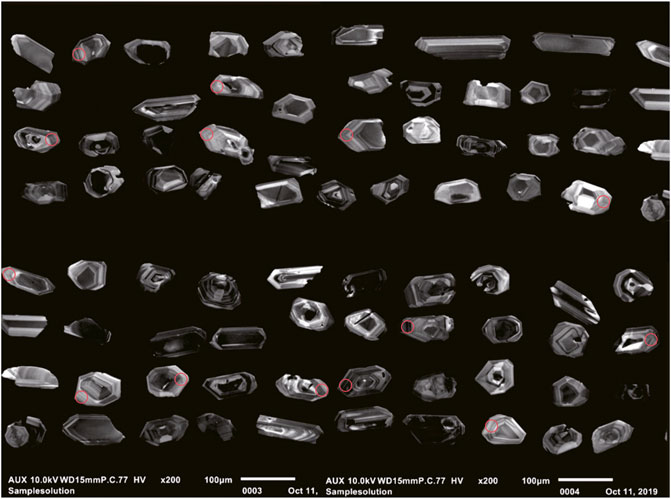
FIGURE 4. Cathodoluminescence images of volcanic zircon in tuff layer of Yanchang Formation. The red circle represents the position of dating spot.
The age distribution of igneous zircons of sample An-3 shows a large dominant 238U/206 Pb age group (n = 14) between 229.2 ± 2.6 Ma and 236.9 ± 2.3 Ma, the weighted mean age is 233.5 ± 1.2 Ma (0.52%, 95% conf., MSWD = 0.92, probability = 0.54, Figure 6A). The age distribution of igneous zircons of sample An-2 shows a large dominant 238U/206 Pb age group (n = 19) from 237.8 ± 2.0 Ma to 241.7 ± 2.2 Ma, the weighted mean age is 240.2 ± 1.1 Ma (0.44%, 95% conf., MSWD = 0.23, probability = 1.000, Figure 6B). The age distribution of igneous zircons of sample MTG-1 shows a large dominant 238U/206 Pb age group (n = 17) between 238.2 ± 3.8 Ma and 243.9 ± 2.0 Ma, the weighted mean age is 241.6 ± 1.1 Ma (Figure 6C). All U–Pb data are presented in Supplementary Table S1.
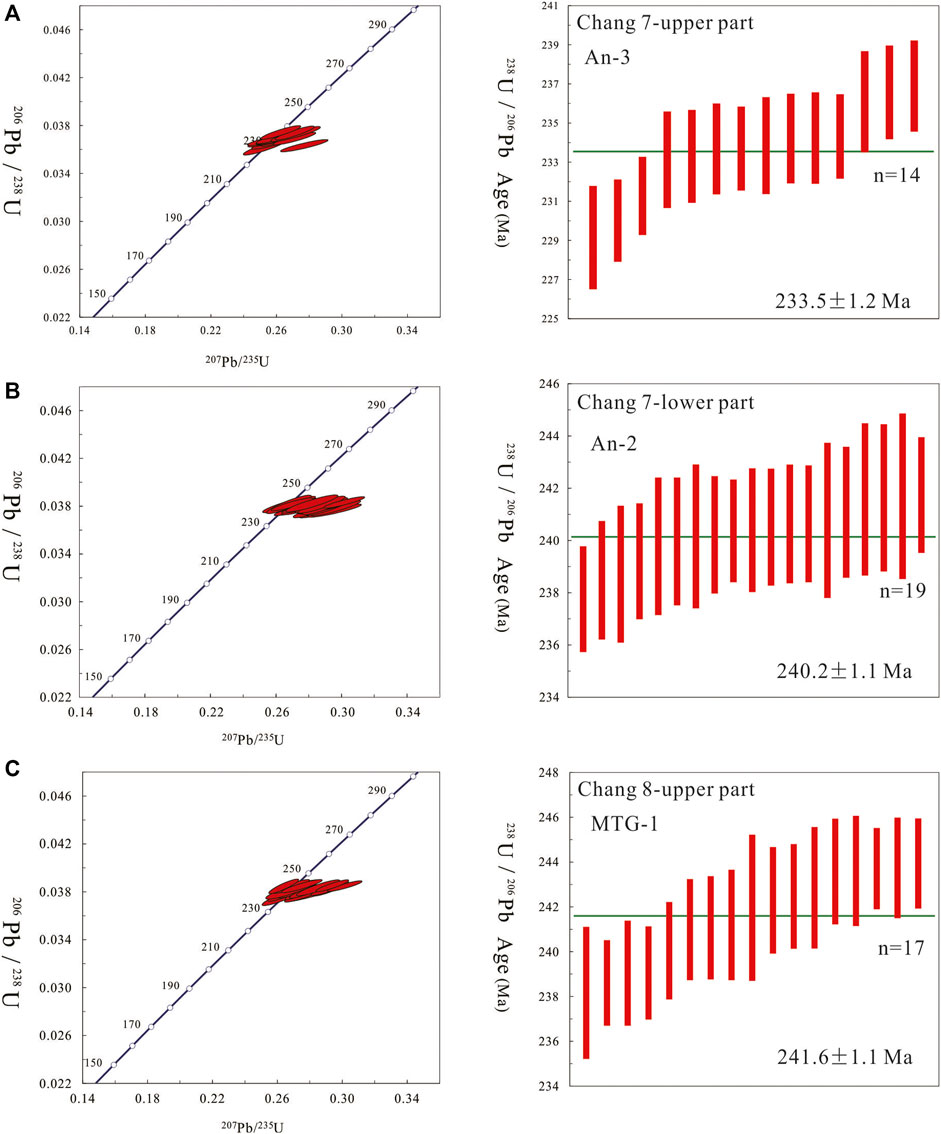
FIGURE 6. Left: U–Pb concordia ages, right: weighted mean age diagram of igneous zircon from three samples in the Yanchang 8–6 members. Only concordant ages are considered (>90%). (A) Sample An-3; (B) Sample An-2; (C) Sample MTG-1.
The Boundary of Chang 7 and Chang 8 Members
The Yanchang Formation includes 10 members (Chang 10 to Chang 1, toward top), and a set of tuff layers were inserted in the Chang 8–6 Members. On the issue of the depositional age of the members, some scholars believe that the whole set of strata belongs to the Upper Triassic (Xi et al., 2020), some scholars believe that the lower section belongs to the Middle Triassic (Chang 7–10 members), and the upper section belongs to the Late Triassic (Chang 1–6 members, Yang, 2002; Deng et al., 2008). Based on sporopollen assemblage and petrology, it is suggested that the oil shale layers in the lower part of Chang 7 Member are marked as the transition from Middle Triassic to Upper Triassic (Deng et al., 2008). The lake level of the Ordos Basin rose to a maximum depth during the sedimentation (Zhang et al., 2019), which was mainly driven by the rapid uplift of the Qinling Belt.
The weighted average ages of three samples in this study are uniform, and close to the depositional age of the stratum. It can be considered as the product of contemporary magmatic activity. The volcanic ages of three samples are consistent with the ages of igneous zircons as commonly observed in the Chang 7 and Chang 8 members (Wang et al., 2014; Zhang et al., 2014; Wang et al., 2017; Deng et al., 2018; Liu et al., 2018; Zhu and Cui, 2019; Sun et al., 2020; Jin et al., 2021). According to the detailed study of stratigraphy and paleontology, the sample An-2 was located at the bottom of Chang 7 Member and the MTG-1 was sampled at the top of Chang 8 Member. The age range of these two samples (241.6–240.2 Ma) is interpreted as the boundary of Chang 7 and Chang 8 members.
Sedimentary Duration of Chang 7 Member
The sedimentary duration of Chang 7 Member is a significant basis for defining the initial evolution of the Ordos Basin. The key point of this study is the identification and analysis of tuff layers of Chang 7 Member from top to bottom.
The lowermost tuff interlayer in Chang 7 Member of Yanchang Formation has been reported in the whole Ordos Basin, and it is the key layer for stratigraphic subdivision and correlation. The tuff layers have been dated by variable methods and produced ages between 226.5 Ma and 241.6 Ma, spanning between the Middle Triassic and the Late Triassic (Figure 7). This variability may be due to the fact that those tuff layers from the upper and lower section of the Chang 7 Member were collected separately and not comparable (Sun et al., 2020). Based on a detailed study of the well An-35, two samples were collected in the Chang 7 Member of one drilling core. The zircon ages indicated that the sedimentary duration of the Chang 7 Member lasted between 240.2 ± 1.1 Ma and 233.5 ± 1.2 Ma.
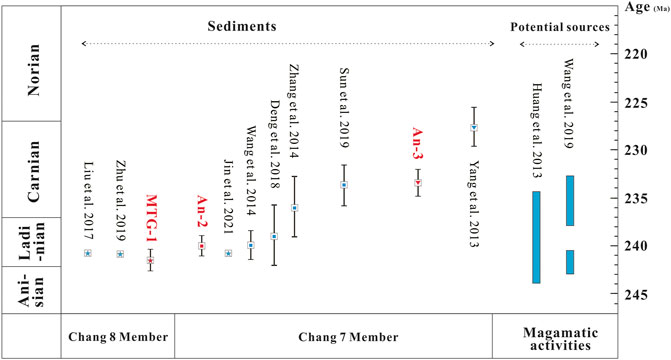
FIGURE 7. Compilation of volcanic zircon U–Pb ages compared with geochronological data of the other contemporary sediments and basement rocks (The blue star/square/column represent the published igneous zircon age and error) (Wang et al., 2014; Zhang et al., 2014; Wang et al., 2017; Deng et al., 2018; Liu et al., 2018; Zhu and Cui, 2019; Sun et al., 2020).
The new age determination allows for correcting the sediment accumulation rates that had been previously estimated for the Chang 7 Member. The distance between these two samples is 90 m (2417–2507 m). According to the age data of tuff layers, the deposition interval is about 6.7 ± 1.2 Ma, and the average deposition rate of the Chang 7 Member is calculated to be 1.34 cm/ka. Based on the Milankovitch cycle theory, previous researchers calculated the average deposition rate of the Chang 7 Member to be 1.31 cm/ka by using the Th curve (Yuan et al., 2016). The deposition rates of the Chang 7 Member calculated by the cyclostratigraphic method are between 0.9 cm/kyr and 2.1 cm/kyr (Chen et al., 2019; Zhang et al., 2019). Therefore, it suggests that the deposition rate in the Chang 7 Member is centered at 1–2 cm/ka.
Initial Indosinian Movement in the Ordos Basin
The Qinling orogenic belt and the Ordos Basin are causally related positive and negative tectonic units under the same dynamic mechanism, both controlled by the multi-cycle Indosinian Movement. Tuff layers of Chang 7 Member are sedimentary records of the volcanic activities in the Qinling orogenic belt. By studying ages of tuff layers, the whole process of volcanic activity in the Qinling Belt is verified and calibrated. The tuff layer ages of sample MTG-1 are not only consistent with the igneous zircons as commonly observed in the Ordos Basin, but also agree with the contemporary magmatic activity (Granite, 245–235 Ma) during the collision of orogeny in the Qinling Belt (Huang et al., 2013; Wang et al., 2019). Furthermore, the zircon age group of the tuff layer in the sample An-2 also matches with the time of tectonic events occurred in the Alxa Massif (Sun et al., 2019a). It indicates that these volcanic zircons were probably sourced from the Triassic magmatic rocks and mafic dykes in the western Alxa Massif (244–239 Ma, Shi et al., 2014).
The Indosinian Movement is of great significance in the history of tectonic evolution in China. The Qinling–Dabie orogenic belt was formed through the convergence and splicing of the North China Plate and the Yangtze Plate (Dong et al., 2015). At this time, the North China Craton on the north side of the Qinling Mountains gradually shrank, and the Ordos Basin began to form (Deng et al., 2008). The predecessors have performed a lot of work on the characteristics of the Indosinian tectonic activity in the Qinling orogenic belt. Deng et al. (2018) estimated the age at the bottom of the extended group is close to 237 Ma. It corresponds to the beginning of the Indosinian Movement in the Qinling orogenic belt. Zhang et al. (2017) reported that the zircon age of the tuff layer at the bottom of the Chang 7 Member is 239.8 ± 2.0 Ma, and the tectonic activity corresponds to the initial stage of the Indosinian Movement. It is adjacent to the Qinling structural belt. According to this research, the initial time of the Indosinian Movement is about 241.6 ± 1.1 Ma and keeping activity till 233.5 ± 1.2 Ma.
To sum up, the final collision between the Yangtze and North China during the Indosinian Movement resulted in the closure of the Mianlue Ocean Basin (northern branch of the Paleo-Tethys Ocean), and the orogenic uplift of the western Qinling area (Dong et al., 2004). The southern part of the Ordos area is strongly compressed by the Qinling orogens, and the northern part is blocked by the Alxa–Yinshan block (Deng et al., 2013). Furthermore, the initial activity stage of the Indosinian Movement increased the extent of the basin depression, and, with black shale and oil shale developed in the deep or semi-deep lake. At the same time, due to the compression of southern stress and the influence of volcanic activity, the northeast wing of the Ordos Basin is wide and gentle, and the southwest wing is steeply inclined. Alluvial fan and fan delta depositional systems develop in the west and southwest margins, and the deposition center is located in the southwest of the basin (Figure 8).
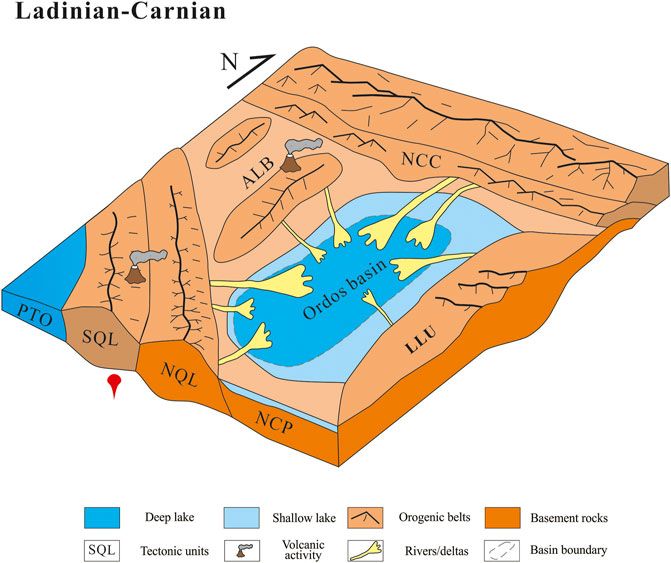
FIGURE 8. Pictorial illustration of paleogeographic reconstruction for the Ordos Basin and surrounding areas during the Late Triassic (not to scale). NCP: North China Plate; SQL: south Qinling orogenic belt; NQL: north Qinling orogenic belt; NCC: North China Continent; ALB: Alxa block; LLU: Lvliang Uplift (modified after Dong et al., 2015; Zhang et al., 2019; Sun et al., 2019a).
Conclusion
Based on the field geological survey and laboratory testing, this research indicates that volcanic activities in the Ordos Basin during the Middle–Late Triassic were recorded from 241.6 Ma to 233.5 Ma. The results suggest that the Indosinian Movement lasted from late Ladinian to early Nornian in the Qinling orogenic belt. The boundary between Middle Chang 8 and Chang 7 members are also defined in the Ladinian. The sedimentary duration of the Chang 7 Member lasted from Ladinian to Carnian with a slow deposition rate.
Data Availability Statement
The original contributions presented in the study are included in the article/Supplementary Material; further inquiries can be directed to the corresponding authors.
Author Contributions
Conceptualization, GL and ZS. Sampling and experiments, GL and GL. Data analysis and figures, MG, GL, and CW. Writing–original draft preparation, GL. Writing–review and editing, ZS and MG. All authors have read and agreed to the published version of the manuscript.
Funding
This research was funded by the National Natural Science Foundation of China (Grant 42002122); State Key Laboratory of Oil and Gas Reservoir Geology and Exploitation (Chengdu University of Technology, Grant PCL2020017).
Conflict of Interest
The authors declare that the research was conducted in the absence of any commercial or financial relationships that could be construed as a potential conflict of interest.
Publisher’s Note
All claims expressed in this article are solely those of the authors and do not necessarily represent those of their affiliated organizations, or those of the publisher, the editors, and the reviewers. Any product that may be evaluated in this article, or claim that may be made by its manufacturer, is not guaranteed or endorsed by the publisher.
Acknowledgments
Thanks go to Xin Jin for providing the samples and insightful discussion concerning interpretation of the data. We are also grateful to the academic editor and reviewers, whose constructive suggestions greatly improved our manuscript.
Supplementary Material
The Supplementary Material for this article can be found online at: https://www.frontiersin.org/articles/10.3389/feart.2022.908940/full#supplementary-material
References
Andersen, T. (2002). Correction of Common Lead in U-Pb Analyses that Do Not Report 204 Pb. Chem. Geol. 192 (1-2), 59–79. doi:10.1016/s0009-2541(02)00195-x
Chen, A. Q., Chen, H. D., Hou, M. C., Lou, Z. H., Xu, S. L., Li, J., et al. (2011). The Middle-Late Triassic Event Sediments in Ordos Basin: Indicators for Episode I of the Indosinian Movement. Acta Geol. Sin. 85, 1681–1689. in Chinese with English abstract.
Chen, G., Gang, W., Liu, Y., Wang, N., Guo, Y., Zhu, C., et al. (2019). High-resolution Sediment Accumulation Rate Determined by Cyclostratigraphy and its Impact on the Organic Matter Abundance of the Hydrocarbon Source Rock in the Yanchang Formation, Ordos Basin, China. Mar. Petroleum Geol. 103, 1–11. doi:10.1016/j.marpetgeo.2019.01.044
Deng, Q., Lin, F. X., Liu, X. Y., Pang, J. L., Lü, J. W., Li, S. X., et al. (2008). Discussion on Relationship between Sedimentary Evolution of the Triassic Yanchang Formation and the Early Indosinian Movement in Ordos Basin. J. Paleogeogr. 10, 159–166. in Chinese with English abstract.
Deng, S., Lu, Y., Luo, Z., Fan, R., Li, X., Zhao, Y., et al. (2018). Subdivision and Age of the Yanchang Formation and the Middle/Upper Triassic Boundary in Ordos Basin, North China. Sci. China Earth Sci. 61 (10), 1419–1439. doi:10.1007/s11430-017-9215-3
Deng, X. Q., Luo, A. X., Zhang, Z. Y., and Liu, X. (2013). Geochronological Comparison on Indosinian Tectonic Events between Qinling Orogeny and Ordos Basin. Acta Sedimentol. Sin. 31 (6), 939–953. in Chinese with English abstract.
Dong, Y., Zhang, G., Zhao, X., Yao, A., and Liu, X. (2004). Geochemistry of the subduction-related magmatic rocks in the Dahong Mountains, northern Hubei Province ? Constraint on the existence and subduction of the eastern Mianle oceanic basin. Sci. China Ser. D. 47 (4), 366–377. doi:10.1360/02yd0486
Dong, Y., Zhang, X., Liu, X., Li, W., Chen, Q., Zhang, G., et al. (2015). Propagation Tectonics and Multiple Accretionary Processes of the Qinling Orogen. J. Asian Earth Sci. 104, 84–98. doi:10.1016/j.jseaes.2014.10.007
Huang, X., Mo, X., Yu, X., Li, X., and He, W. (2013). Zircon U-Pb Chronology, Geochemistry of the Late Triassic Acid Volcanic Rocks in Tanchang Area, West Qinling and Their Geological Significance. Acta Petrol. Sin. 29 (11), 3968–3980. in Chinese with English abstract.
Ji, L.-m., Yan, K., Meng, F.-w., and Zhao, M. (2010). The Oleaginous Botryococcus from the Triassic Yanchang Formation in Ordos Basin, Northwestern China: Morphology and its Paleoenvironmental Significance. J. Asian Earth Sci. 38, 175–185. doi:10.1016/j.jseaes.2009.12.010
Jiang, S. B., Yi, Z. H., and Liang, L. C. (1992). Mesozoic Sedimentary Entities, Superimposed Basins in North China and Their Oil-Gas Occurrences. Oil Gas Geol. 13 (1), 85–96. in Chinese with English abstract. doi:10.11743/ogg19920109
Jin, X., Baranyi, V., Caggiati, M., Franceschi, M., Wall, C. J., Liu, G., et al. (2021). Middle Triassic Lake Deepening in the Ordos Basin of North China Linked with Global Sea-Level Rise. Glob. Planet. Change 207, 103670. doi:10.1016/j.gloplacha.2021.103670
Li, J. L., Wu, X., and Zhang, F. (2008). The Chinese Fossil Reptiles and Their Kin. 2nd ed. Beijing: Science Press, 473. in Chinese with English abstract.
Liu, J., Jahandar, R., Li, L., Shang, Q. H., Xu, G. H., Wang, Y. Q., et al. (2018). High - Precision Temporal Calibration of Middle Triassic Vertebrate Biostratigraphy: U-Pb Zircon Constraints for the Sinokannemeyeria Fauna and Yonghesuchus. Vert. Palasiat. 56, 16–24. doi:10.19615/j.cnki.1000-3118.170808
Liu, J., Li, L., and Li, X. W. (2013). SHRIMP U-Pb Zircon Dating of the Triassic Ermaying and Tongchuan Formations in Shanxi, China and its Stratigraphic Implications. Vert. Palasiat. 51, 162–168. in Chinese with English abstract. doi:10.19615/j.cnki.1000-3118.2013.02.006
Liu, Y., Gao, S., Hu, Z., Gao, C., Zong, K., and Wang, D. (2010). Continental and Oceanic Crust Recycling-Induced Melt-Peridotite Interactions in the Trans-North China Orogen: U-Pb Dating, Hf Isotopes and Trace Elements in Zircons from Mantle Xenoliths. J. Petrology 51, 537–571. doi:10.1093/petrology/egp082
Ludwig, K. R. (2012). User’s Manual for Isoplot 3.75: A Geochronological Toolkit for Microsoft Excel. Berkeley: Geochronology Center Special Publication, 75.
Ma, X. H., Xing, L. S., Yang, Z. Y., Xu, S. J., and Zhang, J. X. (1993). Paleomagnetic Study since Late Paleozoic in the Ordos Basin. Acta Geophys. Sin. 36 (1), 68–79. in Chinese with English abstract.
Meng, Q. R., and Zhang, G. (2015). The North and South China Blocks: Controversy and Reconciliation. Geology 27, 123–126. doi:10.1130/0091-7613(1999)027
Qiu, X., Liu, C., Mao, G., Deng, Y., Wang, F., and Wang, J. (2014). Late Triassic Tuff Intervals in the Ordos Basin, Central China: Their Depositional, Petrographic, Geochemical Characteristics and Regional Implications. J. Asian Earth Sci. 80, 148–160. doi:10.1016/j.jseaes.2013.110.1016/j.jseaes.2013.11.004
Rubatto, D., and Gebauer, D. (2000). Use of Cathodoluminescence for U-Pb Zircon Dating by Ion Microprobe: Some Examples from the Western Alps. Cathodoluminescence Geosciences, 373–400. doi:10.1007/978-3-662-04086-7_15
Scotese, C. R. (2014). Atlas of Middle & Late Permian and Triassic Paleogeographic Maps, Maps 43 - 48 from Volume 3 of the PALEOMAP Atlas for ArcGIS (Jurassic and Triassic) and Maps 49 - 52 from Volume 4 of the PALEOMAP PaleoAtlas for ArcGIS (Late Paleozoic). Evanston, IL. Mollweide Projection, PALEOMAP Project.
Shi, X., Wang, T., Zhang, L., Castro, A., Xiao, X., Tong, Y., et al. (2014). Timing, Petrogenesis and Tectonic Setting of the Late Paleozoic Gabbro-Granodiorite-Granite Intrusions in the Shalazhashan of Northern Alxa: Constraints on the Southernmost Boundary of the Central Asian Orogenic Belt. Lithos 208-209, 158–177. doi:10.1016/j.lithos.2014.08.024
Sun, J., and Dong, Y. (2019b). Middle-Late Triassic Sedimentation in the Helanshan Tectonic Belt: Constrain on the Tectono-Sedimentary Evolution of the Ordos Basin, North China. Geosci. Front. 10 (1), 213–227. doi:10.1016/j.gsf.2018.05.017
Sun, J., and Dong, Y. (2020). Ordovician Tectonic Shift in the Western North China Craton Constrained by Stratigraphic and Geochronological Analyses. Basin Res. 32 (6), 1413–1440. doi:10.1111/bre.12435
Sun, J., and Dong, Y. (2019a). Triassic Tectonic Interactions between the Alxa Massif and Ordos Basin: Evidence from Integrated Provenance Analyses on Sandstones, North China. J. Asian Earth Sci. 169, 162–181. doi:10.1016/j.jseaes.2018.08.002
Sun, Y., Li, X., Liu, Q., Zhang, M., Li, P., Zhang, R., et al. (2020). In Search of the Inland Carnian Pluvial Event: Middle-Upper Triassic Transition Profile and U-Pb Isotopic Dating in the Yanchang Formation in Ordos Basin, China. Geol. J. 55, 4905–4919. doi:10.1002/gj.3691
Wang, D., Xin, B., Yang, H., Fu, J., Yao, J., and Zhang, Y. (2014). Zircon SHRIMP U-Pb Age and Geological Implications of Tuff at the Bottom of Chang-7 Member of Yanchang Formation in the Ordos Basin. Sci. China Earth Sci. 57, 2966–2977. doi:10.1007/s11430-014-4979-0
Wang, F., Tian, J. C., Fan, L. Y., Chen, R., and Qiu, J. L. (2010). Evolution of Sedimentary Fillings in Triassic Yanchang Formation and its Response to Indosinian Movement in Ordos Basin. Nat. Gas. Geosci. 21, 882–889. in Chinese with English abstract.
Wang, J. Q., Liu, C. Y., Li, X., Wu, T. T., and Wu, J. L. (2017). Geochronology, Potential Source and Regional Implications of Tuff Intervals in Chang-7 Member of Yanchang Formation, South of Ordos Basin. Acta Sedimentol. Sin. 35, 691–704. in Chinese with English abstract. doi:10.14027/j.cnki.cjxb.2017.04.004
Wang, M., Pei, X., Li, R., Li, Z., Pei, L., Chen, Y., et al. (2019). Early Indosinian High-Mg# and High-Sr/Y Ratio Granodiorites in the Xiahe Area, West Qinling, Central China: Petrogenesis and Geodynamic Implications. Lithos 332-333, 162–174. doi:10.1016/j.lithos.2019.03.005
Wu, X. C., Liu, J., and Li, J. L. (2001). The Anatomy of the First Archosauriform (Diapsida) from the Terrestrial Upper Triassic of China. Vert. Palasiat. 39, 251–265. in Chinese with English abstract. doi:10.19615/j.cnki.1000-3118.2001.04.002
Xi, K., Li, K., Cao, Y., Lin, M., Niu, X., Zhu, R., et al. (2020). Laminae Combination and Shale Oil Enrichment Patterns of Chang 73 Sub-member Organic-Rich Shales in the Triassic Yanchang Formation, Ordos Basin, NW China. Petroleum Explor. Dev. 47 (6), 1342–1353. doi:10.1016/s1876-3804(20)60142-8
Xie, X., and Heller, P. L. (2013). U-pb Detrital Zircon Geochronology and its Implications: the Early Late Triassic Yanchang Formation, South Ordos Basin, China. J. Asian Earth Sci. 64, 86–98. doi:10.1016/j.jseaes.2012.11.045
Xu, F., Zhu, Z. W., Li, C. C., and Yang, Z. G. (2019). Characteristics and Geological Significance of Thick Ignimbrite Beds of Yanchang Formation (Chang 7 Section) in Southeastern Ordos Basin. Geoscience 33 (2), 389–400. in Chinese with English abstract. doi:10.19657/j.geoscience.1000-8527.2019.02.14
Yang, H., and Deng, X. Q. (2013). Deposition of Yanchang Formation Deep-Water Sandstone under the Control of Tectonic Events, Ordos Basin. Pet. Explor Dev. 40, 513–520. in Chinese with English abstract. doi:10.1016/s1876-3804(13)60072-5
Yang, J. (2002). Tectonic Evolution and Hydrocarbon Distribution in Ordos Basin. Petroleum Industry Press, 58–89. in Chinese with English abstract.
Yang, R., Jin, Z., van Loon, A. J., Han, Z., and Fan, A. (2017). Climatic and Tectonic Controls of Lacustrine Hyperpycnite Origination in the Late Triassic Ordos Basin, Central China: Implications for Unconventional Petroleum Development. Bulletin 101, 95–117. doi:10.1306/06101615095
Yuan, W., Liu, G., and Luo, W. (2016). Deposition Rate of the Seventh Member of Yangchang Formation, Ordos Basin and its Impact on Organic Matter Abundance of Hydrocarbon Source Rock. J. Xi’an Shiyou Univ. Nat. Sci. Ed. 31 (5), 20–26. in Chinese with English abstract. doi:10.3969/j.issn.1673-064X.2016.05.003
Zhang, H., Peng, P. A., and Zhang, W. Z. (2014). Zircon U-Pb Ages and Hf Isotope Characterization and Their Geological Significance of Chang 7 Tuff of Yanchang Formation in Ordos Basin. Acta Petrol. Sin. 30 (2), 565–575. in Chinese with English abstract.
Zhang, R., Jin, Z., Liu, Q., Li, P., Huang, Z., Shi, J., et al. (2019). Astronomical Constraints on Deposition of the Middle Triassic Chang 7 Lacustrine Shales in the Ordos Basin, Central China. Palaeogeogr. Palaeoclimatol. Palaeoecol. 528, 87–98. doi:10.1016/j.palaeo.2019.04.030
Zhang, W., Yang, W., and Xie, L. (2017). Controls on Organic Matter Accumulation in the Triassic Chang 7 Lacustrine Shale of the Ordos Basin, Central China. Int. J. Coal Geol. 183, 38–51. doi:10.1016/j.coal.2017.09.015
Zhang, W. Z., Yang, H., Peng, P. A., Yang, Y. H., Zhang, H., and Shi, X. H. (2009). The Influence of Late Triassic Volcanism on the Development of Chang 7 High Grade Hydrocarbon Source Rock in Ordos Basin. Geochemica 38 (6), 573–582. in Chinese with English abstract. doi:10.19700/j.0379-1726.2009.06.007
Zhao, X., Coe, R. S., Liu, C., and Zhou, Y. (1992). New Cambrian and Ordovician Paleomagnetic Poles for the North China Block and Their Paleogeographic Implications. J. Geophys. Res. 97 (B2), 1767–1788. doi:10.1029/91JB02742
Zhu, R., Cui, J., Deng, S., Luo, Z., Lu, Y., and Qiu, Z. (2019). High‐precision Dating and Geological Significance of Chang 7 Tuff Zircon of the Triassic Yanchang Formation, Ordos Basin in Central China. Acta Geol. Sin. ‐ Engl. Ed. 93 (6), 1823–1834. doi:10.1111/1755-6724.14329
Keywords: Chang 7 Member, Upper Triassic, tuff layer, zircon U–Pb ages, Indosinian Movement
Citation: Lu G, Gou M, Liu G, Wang C and Shi Z (2022) Zircon U–Pb Dating of Tuff Layers in the Middle–Upper Triassic Strata of Successions and Sedimentation of Chang 7 Member in the Ordos Basin, China. Front. Earth Sci. 10:908940. doi: 10.3389/feart.2022.908940
Received: 31 March 2022; Accepted: 17 June 2022;
Published: 26 August 2022.
Edited by:
Hajime Naruse, Kyoto University, JapanCopyright © 2022 Lu, Gou, Liu, Wang and Shi. This is an open-access article distributed under the terms of the Creative Commons Attribution License (CC BY). The use, distribution or reproduction in other forums is permitted, provided the original author(s) and the copyright owner(s) are credited and that the original publication in this journal is cited, in accordance with accepted academic practice. No use, distribution or reproduction is permitted which does not comply with these terms.
*Correspondence: Gang Lu, lugang19@cdut.edu.cn; Zhiqiang Shi, szqcdut@163.com
 Gang Lu
Gang Lu Mingxing Gou2
Mingxing Gou2 
